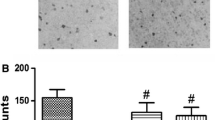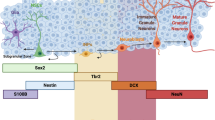Abstract
Purpose
Obstructive sleep apnea (OSA) is characterized by repetitive upper airway collapse during sleep, which induces chronic intermittent hypoxia (CIH). CIH results in low-grade inflammation, sympathetic overactivity, and oxidative stress. Nevertheless, it remains unclear how exposure to CIH affects olfaction. The purpose of this study was, therefore, to investigate the cytotoxic effects of CIH exposure on mouse olfactory epithelium and the underlying pathophysiology involved.
Methods
Mice were randomly divided into four groups: Youth mouse (You) + room air (RA), You + intermittent hypoxia (IH), Elderly mouse (Eld) + RA, and Eld + IH (n = 6 mice/group). Mice in the two hypoxia groups were exposed to CIH. The control condition involved exposure to room air (RA) for 4 weeks. Olfactory neuroepithelium was harvested for histologic examination, gene ontology analysis, quantitative real-time polymerase chain reaction (qRT-PCR), and western blotting.
Results
Based on qRT-PCR analysis, olfactory marker protein (OMP), Olfr1507, ADCY3, and GNAL mRNA levels were lower, whereas NGFR, CNPase, NGFRAP1, NeuN, and MAP-2 mRNA levels were higher in the You + IH group than in the You + RA group. Olfactory receptor-regulated genes, neurogenesis-related genes and immunohistochemical results were altered in nasal neuroepithelium under CIH exposure.
Conclusions
Based on genetic and cytologic analysis, CIH impacted the olfactory neuroepithelium in an age-dependent manner. Our findings suggest that CIH-induced damage to the olfactory neuroepithelium may induce more severe change in the youth than in the elderly.




Similar content being viewed by others
References
Benjafield AV, Ayas NT, Eastwood PR et al (2019) Estimation of the global prevalence and burden of obstructive sleep apnoea: a literature-based analysis. Lancet Respir Med 7(8):687–698
Arnaud C, Dematteis M, Pepin JL et al (2009) Obstructive sleep apnea, immuno-inflammation, and atherosclerosis. Semin Immunopathol 31(1):113–125
Baguet JP, Barone-Rochette G, Tamisier R et al (2012) Mechanisms of cardiac dysfunction in obstructive sleep apnea. Nat Rev Cardiol 9(12):679–688
Kobrick JL, Zwick H, Witt CE, Devine JA (1984) Effects of extended hypoxia on night vision. Aviat Space Environ Med 55(3):191–195
Wagner LS, Oakley SR, Vang P et al (2011) Hypoxia-induced changes in standing balance. Aviat Space Environ Med 82(5):518–522
La BP (1878) pression barometrique: recherches de physiologies experimentale. Masson, Parus
Kuehn M, Welsch H, Zahnert T, Hummel T (2008) Changes of pressure and humidity affect olfactory function. Eur Arch Otorhinolaryngol 265(3):299–302
Doty RL (2018) Age-related deficits in taste and smell. Otolaryngol Clin North Am 51(4):815–825
Kang HH, Kim IK, Lee HI et al (2017) Chronic intermittent hypoxia induces liver fibrosis in mice with diet-induced obesity via TLR4/Myd88/MAPK/NF-Kb signaling pathways. Biochem Biophys Res Commun 490(2):349–355
Shin DH, Ahn SH, Yang Y, Choi S, Cho JH, Hong SC et al (2017) The effect of sleep disordered breathing on olfactory functions: analysis by apnea-hypopnea index. Clin Exp Otorhinolaryngol 10(1):71–76
Stepank J. Influence of Hypobaric Hypoxia on the Human Sense of Smell. In: Thesis (Master of Public Health). Galvestone: The University of Texas Graduate School of Biomedical Sciences; 2002.
Altundağ A, Salihoglu M, Çayönü M et al (2014) The effect of high altitude on olfactory functions. Eur Arch Otorhinolaryngol 271(3):615–618
Kühn M, Welsch H, Zahnert T, Hummel T (2009) Is olfactory function impaired in moderate height? Laryngorhinootologie 88(9):583–586
Drobyshevsky A, Robinson AM, Derrick M et al (2006) Sensory deficits and olfactory system injury detected by novel application of MEMRI in newborn rabbit after antenatal hypoxia-ischemia. Neuroimage 32(3):1106–1112
Chang AJ, Ortega FE, Riegler J, Madison DV, Krasnow MA (2015) Oxygen regulation of breathing through an olfactory receptor activated by lactate. Nature 527(7577):240–244
Pinto JM (2011) Olfaction. Proc Am Thorac Soc 8(1):46–52
Murphy C, Cain WS, Gilmore MM, Skinner RB (1991) Sensory and semantic factors in recognition memory for odors and graphic stimuli: elderly versus young persons. Am J Psychol 104(2):161–192
Murphy C, Nordin S, Acosta L (1997) Odor learning, recall, and recognition memory in young and elderly adults. Neuropsychology 11(1):126–137
Evans WJ, Cui L, Starr A (1995) Olfactory event-related potentials in normal human subjects: effects of age and gender. Electroencephalogr Clin Neurophysiol 95(4):293–301
Hummel T, Barz S, Pauli E, Kobal G (1998) Chemosensory event-related potentials change with age. Electroencephalogr Clin Neurophysiol 108(2):208–217
Morgan CD, Murphy C (2010) Differential effects of active attention and age on event-related potentials to visual and olfactory stimuli. Int J Psychophysiol 78(2):190–199
Murphy C, Nordin S, de Wijk RA et al (1994) Olfactory-evoked potentials: assessment of young and elderly, and comparison to psychophysical threshold. Chem Senses 19(1):47–56
Stuck BA, Frey S, Freiburg C, Hörmann K et al (2006) Chemosensory event-related potentials in relation to side of stimulation, age, sex, and stimulus concentration. Clin Neurophysiol 117(6):1367–1375
Reske M, Kellermann T, Shah NJ et al (2010) Impact of valence and age on olfactory induced brain activation in healthy women. Behav Neurosci 124(3):414–422
Wang J, Sun X, Yang QX (2017) Early aging effect on the function of the human central olfactory system. J Gerontol A Biol Sci Med Sci 72(8):1007–1014
Kim BY, Park JY, Kim E, Kim BG (2020) Olfactory ensheathing cells mediate neuroplastic mechanisms after olfactory training in mouse model. Am J Rhinol Allergy 34(2):217–229
Kim BY, Park JY, Kim E (2020) Differences in mechanisms of steroid therapy and olfactory training for olfactory loss in mice. Am J Rhinol Allergy 34(6):810–821
Deumens R, Koopmans GC, Lemmens M et al (2006) Neurite outgrowth promoting effects of enriched and mixed OEC/ONF cultures. Neurosci Lett 417:20–26
Zhang C, Wang X (2017) Initiation of the age-related decline of odor identification in humans: a meta-analysis. Ageing Res Rev 40:45–50
Doty RL, Shaman P, Dann M (1984) Development of the University of Pennsylvania smell identification test: a standardized microencapsulated test of olfactory function. Physiol Behav 32(3):489–502
Doty RL, Shaman P, Applebaum SL et al (1984) Smell identification ability: changes with age. Science 226(4681):1441–1443
Kremer S, Mojet J, Kroeze JHA (2007) Differences in perception of sweet and savoury waffles between elderly and young subjects. Food Qual Pref 18:106–116
Larsson M, Nilsson LG, Olofsson JK, Nordin S (2004) Demographic and cognitive predictors of cued odor identification: evidence from a population-based study. Chem Senses 29(6):547–554
Pinto JM, Schumm LP, Wroblewski KE et al (2014) Racial disparities in olfactory loss among older adults in the United States. J Gerontol A Biol Sci Med Sci 69(3):323–329
Fordyce ID (1961) Olfaction tests. Br J Ind Med 18(3):213–215
Murphy C (1983) Age-related effects on the threshold, psychophysical function, and pleasantness of menthol. J Gerontol 38(2):217–222
Stuck BA, Frey S, Freiburg C et al (2006) Chemosensory event-related potentials in relation to side of stimulation, age, sex, and stimulus concentration. Clin Neurophysiol 117(6):1367–1375
Schiffman SS (1992) Olfaction in aging and medical disorders. In: Serby MJ, Chobor KL (eds) Science of olfaction. Springer, New York, pp 500–525
Pourié G, Akchiche N, Millot JL et al (2020) The fate of transplanted olfactory progenitors is conditioned by the cell phenotypes of the receiver brain tissue in cocultures. Int J Mol Sci 21(19):7249
Funding
This research was supported by Basic Science Research Program through the National Research Foundation of Korea (NRF) funded by the Ministry of Education (2021R1I1A1A01044354).
Author information
Authors and Affiliations
Contributions
Conceived and designed the manuscript: BYK. Analyzed the data: BYK, JHB, and JYP. Contributed reagents/materials/analysis tools: BYK, IKK, and SHL. Wrote the paper: BYK, IKK, and SHL.
Corresponding author
Ethics declarations
Conflict of interest
The author(s) declare that they have no conflict of interest.
Additional information
Publisher's Note
Springer Nature remains neutral with regard to jurisdictional claims in published maps and institutional affiliations.
Rights and permissions
About this article
Cite this article
Kim, BY., Lee, S.H., Kim, I.K. et al. Chronic intermittent hypoxia impacts the olfactory nervous system in an age-dependent manner: pilot study. Eur Arch Otorhinolaryngol 280, 241–248 (2023). https://doi.org/10.1007/s00405-022-07529-x
Received:
Accepted:
Published:
Issue Date:
DOI: https://doi.org/10.1007/s00405-022-07529-x




